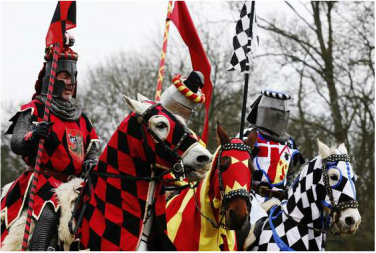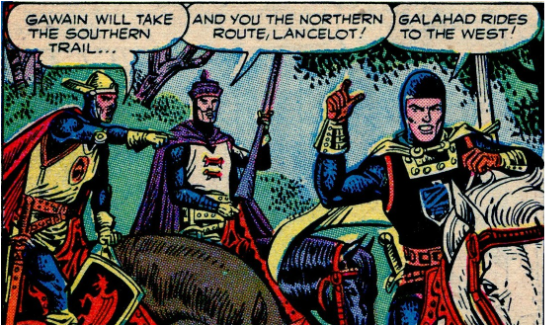 Knights and horses prepared for battle
Knights and horses prepared for battle The Knights of the Round Table (real or mythical) are rarely pictured on foot. We see them in full armor mounted on massive war horses, a combination of man and beast representing the medieval equivalent of a battle tank. Unfortunately nothing could be farther from the truth. The mounted knight was the weakest link in the war machine and his horse was, quite literally, his downfall. A knight who went into battle on horseback very often came back on foot or on someone else's horse, or not at all.
 Knights attacking each other with swords
Knights attacking each other with swords While there is no doubt that medieval knights rode into battle on horses, there is also no doubt that the first task of an archer or foot soldier was to bring down the horse and leave the knight to fight on foot. The image of a knight in armor with his horse hung in brightly covered cloth is not a battle image, it is an image from the tourney. For knights the tournament or tourney was a major source of income far more lucrative and far less dangerous than fighting in an actual battle. Fighting in a tournament did not usually mean fighting to the death, although death was possible given the nature of the game and the use of sharp blades, heavy clubs, and pointed lances.
 Wandering knights ready for a fight
Wandering knights ready for a fight The legends of the Knights of the Round Table tell of groups of knights riding somewhat randomly through the countryside righting wrongs, rescuing maidens, and fighting various beasts and villains. It is quite possible that these are not distant memories of a group of saintly warriors. More likely they spring from the exploits of the itinerant tournament knights who traveled the length and breadth of Europe looking for the next high paying event. Rather like bands of bare knuckle boxers or cage fighters, they made their living by beating up on each other for the entertainment of the nobility and the general population . The tournament was always a popular attraction but the roving bands of armored, testosterone-driven knights traveling to and from these events eventually became so dangerous to local populations that in 1130 Pope Innocent II denounced the tournaments and forbade Christian burial for those killed in them. Of course no one went into a tournament expecting to be killed, so the burial ban did little to discourage them and they continued to draw thousands of spectators and give penniless knights a way to make a living. If you had a horse and armor you had a way to make money.
 "Sir Tristam fights in the Melee"
"Sir Tristam fights in the Melee" When the tourney came to town, it really came to town; in fact all over the town, the fields, villages, and other people's property. To get a taste of a melee, visit Butler County in Pennsylvania where the medieval experience is recreated annually in the Pennsic Wars In the early middle ages the melee was the chief event of the tournament, a mass mock battle with knights fighting either individually or in teams to capture and ransom their opponents, dragging them off their horses and either rendering them unconscious or having them cry "yield". This was the most brutal part of the tournament, but it offered the best chance to win gold, armor and a lady's favor. William Marshall the greatest knight of his time owed his life and his later success to his years as a tourney knight.
 A lady bestowing her favor on a knight
A lady bestowing her favor on a knight Rules were established in 1292 to bring order to the chaos and some of the new rules involved protection for the horses. In part this was, no doubt, the result of the involvement of the ladies of the court. The traditions of chivalry (the root word of chivalry is "cheval" or "horse") and courtly love were introduced to the tournament circuit. Knights now fought to impress the great ladies. A knight would select a married lady, usually of slightly higher rank, and fight for her honor and approval. The story of Lancelot being chosen as the Queen's knight reflects this tradition. The knight is supposed to fight for and yearn for a lady who is high above him and unapproachable. The Rules of Courtly Love made this game a little less dangerous than it would first appear to be.
 The Knights of the Round Table set out on a quest
The Knights of the Round Table set out on a quest These days we often use the word "jousting" to define a medieval tournament, but the joust was only a minor event compared to the melee. Jousting involved one knight riding against another with nothing but a lance as a weapon and required considerable skill.
Although jousting could win a lady's favor and a purse of gold, it was the melee that brought true rewards and it was the knights of the melee who traveled the countryside . Maybe this is the source of the legend of the Knights of the Round Table, or maybe the legend came from somewhere else, somewhere far away. I have explored this in the Excalibur Rising series. Book One will take you on the path to Excalibur.
Although jousting could win a lady's favor and a purse of gold, it was the melee that brought true rewards and it was the knights of the melee who traveled the countryside . Maybe this is the source of the legend of the Knights of the Round Table, or maybe the legend came from somewhere else, somewhere far away. I have explored this in the Excalibur Rising series. Book One will take you on the path to Excalibur.
 RSS Feed
RSS Feed